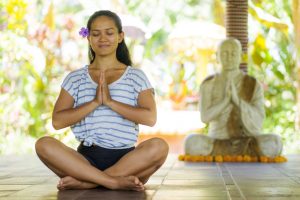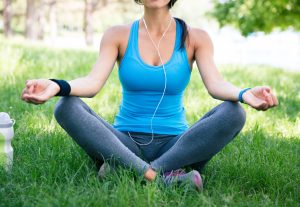Breath is the source of life. Healthy breathing is important to balance and also reduction in anxiety. In meditation, breathing frequency and depth play a role in relaxation and stress reduction. Many in the East have fashioned certain breathing techniques to enhance meditation relaxation for both mental and spiritual reasons. Incorporating such daily breathing exercises can help well beyond meditation purposes, but also better health in regards to blood pressure and heart health.

In the article, “How Daily Breathing Exercises Can Help Lower Blood Pressure as Much as Medication” by Eileen Bailey looks at the importance of daily breathing for overall health. In the article, a study is reviewed that shows a significant impact on lowering blood pressure among participants. In essence, daily deep breathing has many therapeutic short term and long term effects in lowering stress in life and hence reducing blood pressure. The article states,
“Using breathing techniques for 5 to 10 minutes a day might help lower blood pressure, according to a study completed at the University of Colorado, Boulder, and the University of Arizona. In their study, researchers instructed participants to complete breathing exercises for 5 to 10 minutes daily using a breathing device. The participants were told to take 30 breaths as the machine provided resistance, so their respiratory muscles worked harder. The trial lasted six weeks.”
“How Daily Breathing Exercises Can Help Lower Blood Pressure as Much as Medication”. Eileen Bailey. Healthline. September 28th, 2022
To review the entire article, please click here
Commentary
Deep breathing is a technique that can be used to help promote relaxation. When we breathe deeply, it activates the parasympathetic nervous system, which is responsible for rest and digest functions. This can help to decrease heart rate and blood pressure, and can also help to reduce stress hormones like cortisol. Deep breathing is also thought to help improve circulation and increase oxygenation of the blood.
There are four types of deep breathing: abdominal, costal, clavicular, and diaphragmatic. Abdominal breathing is when the stomach expands while the person inhales. Costal breathing is when the ribs move up and out while the person inhales. Clavicular breathing is when the shoulders rise while the person inhales. Diaphragmatic breathing is when the diaphragm contracts while the person inhales.
Deep Breathing
When you inhale, your diaphragm contracts and moves downward. This increases the volume of your thoracic cavity and causes your lungs to expand and fill with air. The intercostal muscles between your ribs also help lift your chest and increase the volume of your thoracic cavity. As a result, atmospheric pressure decreases and air flows into your lungs.
When you exhale, your diaphragm relaxes and moves upward. When we breathe deeply, it sends a signal to our brain to relax. This happens because when we breathe deeply, it activates the vagus nerve, which is responsible for slowing down our heart rate. When our heart rate slows down, we feel more relaxed. Additionally, deep breathing increases the levels of oxygen in our blood, which helps to reduce stress hormones like cortisol.
When is the best time to utilize deep breathing? There is no definitive answer to this question as it depends on the individual and the situation. However, deep breathing can be helpful in managing stress and anxiety, so it may be beneficial to do so when you are feeling overwhelmed or stressed. Additionally, deep breathing can help to improve focus and concentration, so it may be beneficial to do so before beginning a task that requires your full attention.
In regards to daily routine, it is best to deep breathe to start the day and end the day.
Benefits on Blood Pressure
One of the most common medical conditions in the world is high blood pressure, or hypertension. This condition occurs when the force of blood against your artery walls is too high. Over time, this can lead to serious health problems, such as heart disease, stroke, and kidney failure. There are many different factors that can contribute to high blood pressure, including genetic factors, diet, stress, and other medical conditions. Treatment for high blood pressure typically involves lifestyle changes and medication. Deep breathing is an additional way to reduce stress and hence lower blood pressure.
How does this react to lowering blood pressure? As stated, when the parasympathetic nervous system is activated, blood pressure drops. With less stress, less flight of fight response, blood pressure naturally can drop. Through continued and consistent daily breathing exercises, one can then lower blood pressure over time. Other benefits of deep breathing include improved blood circulation, increased lung capacity, and reduced stress levels. Additionally, deep breathing can help to improve sleep quality and digestion.
Conclusion
In conclusion, deep breathing is a simple and effective way to lower blood pressure. Deep breathing slows the heart rate and lowers blood pressure by allowing the body to release tension and relax. Try deep breathing for a few minutes every day to see if it can help lower your blood pressure. You can utilize deep breathing when stressed at work, school or home, or whenever stress finds you. You should however though implement it into everyday life even when not stressed as to prepare the body for the day and create a lower blood pressure to start the day.
Please also review AIHCP’s Meditation Instructor Certification and see if it meets your academic and professional goals. The program is online and independent study and open to qualified professionals seeking a four year certification in Meditation. Utilizing deep breathing techniques as a meditation instructor can help many learn to face stress and in the process lower their blood pressure.
Additional Resources
“The impact of music guided deep breathing exercise on blood pressure control – A participant blinded randomised controlled study”. Kow Fei Ping, et,al. Clinical Research Centre, Hospital Pulau Pinang, Georgetown, Pulau Pinang, Malaysia. Med J Malaysia, 2018. Access here
“17 Effective Ways to Lower Your Blood Pressure”. Marjorie Hecht. Healthline. October 21st, 2022. Access here
“Meditation and a relaxation technique to lower blood pressure”. Heart Health. Harvard Health Publishing. June 14th, 2020. Access here
“10 ways to control high blood pressure without medication”. Mayo Clinic Staff. Mayo Clinic. July 12th, 2022. Access here









